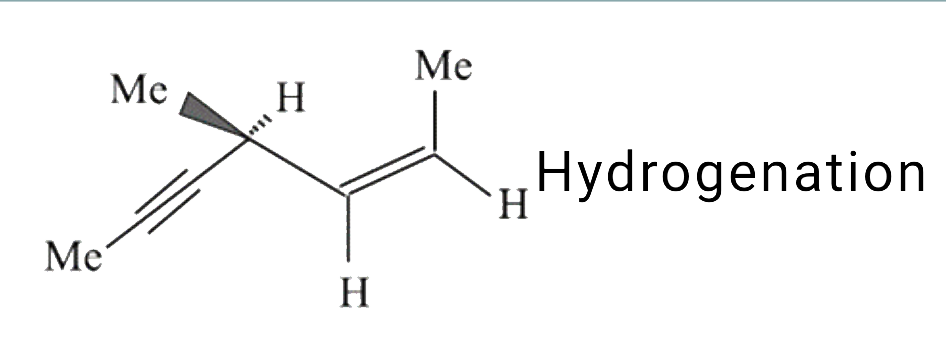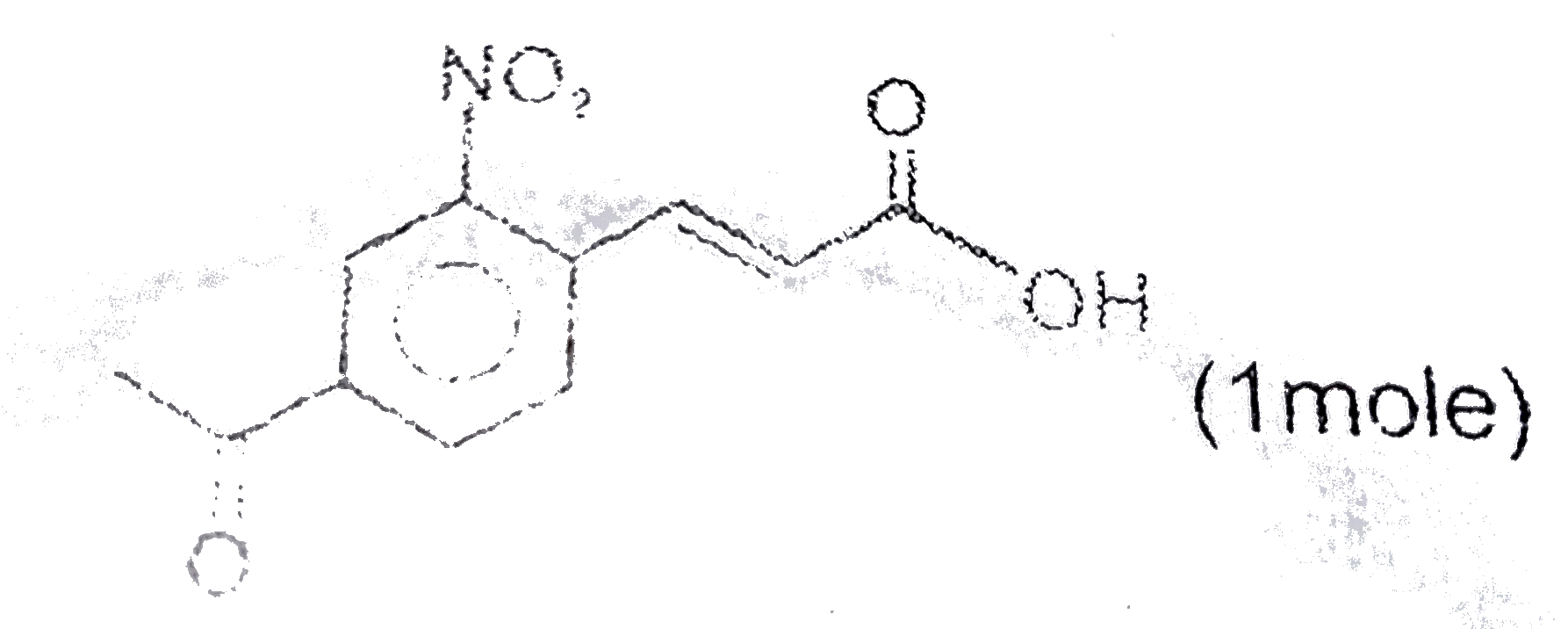An alkyl halide C5H11 (A) reacts with ethanolic KOH to give an alkene 'B' which reacts with Br2 to give a compound 'C' which on dehydromination gives an alkyne 'D' . On treatment with sodium metal in liquid ammonia one mole of 'D' give one mole of the sodium salt of 'D' and half a mole of hydrogen gas . Complete hydrogenation of 'D' yields a straight chain alkane. Identify A, B, C and D . Give the the reactions involved.
underset("(A)")(underset("Alkyl halide")(C_(5)H_(11)Br)) overset("alc. КОН")to underset("(B)")(underset("Alkene")(C_(5)H_(10))) overset(Br_(2))to underset("(C)")(C_(5)H_(10)Br_(2))underset("alc. KOH")overset("dehydrobromination")to underset("(D)")underset("Alkyne")(C_(5)H_(8))
C5H8(D)Na, liq.NH3−−−−−−→C5H7NaSodium alkylide+12H2
The reaction suggest that (D) is a terminal alkyne. The possible structures are :
CH3CH2CH2C≡CH(I) CH3C∣CH3HC≡CH(II)
Since alkyne (D) gives straight chain on complete hydrogenation, therefore, only structure (I) is possible. Hence the reactions may be written as:
CH3CH2CH2CH2CH2Bralc. KOH−−−−→CH3CH2CH2=CH2Br2−−→CH3CH2CH2C∣BrHCH2−Bralc. KOH−−−−→CH3CH2CH2C≡CHNa. liq.NH3−−−−−−→CH3CH2CH2C≡CNa+
and CH3CH2CH2C≡2H2−−→CH3CH2CH2CH2CH3
Hence the structures of A, B, C and D are :
(A) CH3CH2CH2CH2CH2Br
(B) CH3CH2CH2CH=CH2
(C) CH3CH2CH2CH(Br)CH2Br
(D) CH3CH2CH2≡CH
Topper's Solved these Questions
- HYDROCARBONSBOOK - MODERN PUBLICATIONCHAPTER - HYDROCARBONSEXERCISE - PRACTICE PROBLEMS
34 Videos
- HYDROCARBONSBOOK - MODERN PUBLICATIONCHAPTER - HYDROCARBONSEXERCISE - Conceptual Questions
20 Videos
- HALOALKANES AND HALOARENESBOOK - MODERN PUBLICATIONCHAPTER - HALOALKANES AND HALOARENESEXERCISE - UNIT PRACTICE TEST
12 Videos
- HYDROGENBOOK - MODERN PUBLICATIONCHAPTER - HYDROGENEXERCISE - UNIT PRACTICE TEST (for Board Examination)
9 Videos
Similar Questions
An alkyl halide C5H11 (A) reacts with ethanolic KOH to give an alkene 'B' which reacts with Br2 to give a compound 'C' which on dehydromination gives an alkyne 'D' . On treatment with sodium metal in liquid ammonia one mole of 'D' give one mole of the sodium salt of 'D' and half a mole of hydrogen gas . Complete hydrogenation of 'D' yields a straight chain alkane. Identify A, B, C and D . Give the the reactions involved.
View SolutionPrimary alkyl halide C4H9Br (A) is reacted with alcoholic KOH to give compound (B). The ompound (B) is reacted with HBr to give (C) which is an isomer of compound (A). Write the structures of the compounds (A), (B) and (C).
View Solution
Knowledge Check
Benzamide is reacted with sodium metal in
ethanol givesAAnilineBBenzyl amineCbenzoic acidDBenzaldehyde Hydrogenation of the above compound in the presence of sodium in liquid ammonia gives - AAn optically active compoundBAn optically inactive compoundCA racemic mixtureDA diastereomeric mixture
Hydrogenation of the above compound in the presence of sodium in liquid ammonia gives - AAn optically active compoundBAn optically inactive compoundCA racemic mixtureDA diastereomeric mixtureWhen one mole of the given compond reacts with sodium metal then how many moles of H2 gas will release ?
 A1 moleB1.5 moleC2 moleD0.5 mole
A1 moleB1.5 moleC2 moleD0.5 mole
An alkyl halide C4H9Br,[A] reacts with alcoholic KOH and formes an alkene [B] which reacts with bromine to give a dibromide [C]. The compound [C] is converted to a gas [D] upon reacting with sodalide. The gas when passed through ammoniacal silver nitrate solution, gives a white precipitate. give the structural formula of the compounds [A],[B],[C] and [D].
View SolutionA compound (A) of boron reacts with Nme3 to give an adduct (B) which on hydrolysis gives a compound (C) and hydrogen gas. Compound (C) is an acid. Identify the compounds A,B and C. give the reactions inovolved.
View SolutionPrimary alkyl halide C4H9Br (X) reacts with alc. KOH to give compound (Y). (Y) reacts with HBr to give compound (Z) which is an isomer of (X). When (X) reacts with Na metal it gives compound (P). (X), (Y), (Z) and (P) are
View SolutionAlkyl halides react with……reagents to give alkanes
View SolutionWhen one mole of the given compound reacts with sodium metal then how many moles of H2 gas will release ?

View Solution
